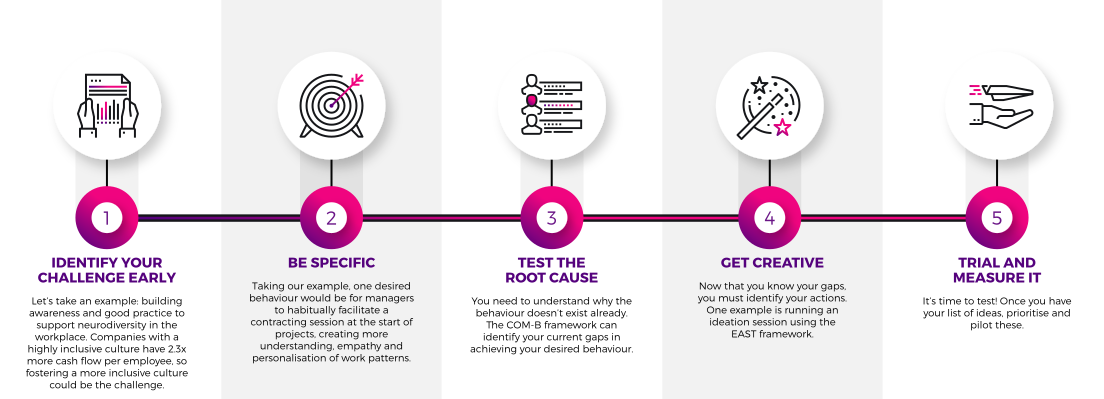Inclusivity in the workplace can feel like a lot of words with little action and people are now looking for tangible changes in their work culture. Behavioural science is now being used to unlock the small day-to-day differences that can cause a positive ripple effect.
We use behaviour labs to identify actions and behaviours to drive tangible change. When applied to the challenge of making the workplace more inclusive, it helps us bridge the action-intention gap.
Here are our 5 steps for running a behaviour lab with an inclusivity focus:

#1: Clearly identify your challenge
To start, it’s critical to clearly and accurately articulate the challenge. Let’s use the example of building awareness and good practice around supporting neurodiversity in the workplace, something we recently did with a professional services firm. Companies with a highly inclusive culture have 2.3x more cash flow per employee1 and this organisation wanted to foster a more inclusive culture by working on this challenge.
#2: Be specific about identifying behaviours
When it comes to identifying behaviours, it’s essential to be specific. A behaviour is “an action that is observable” – you need to be able to measure it!
Take our case study of supporting neurodiversity in the workplace. One desired behaviour was for managers to habitually facilitate a contracting session for their team at the beginning of a project, creating more understanding, empathy and personalisation of work patterns.
#3: Test the root cause
We need to answer the question of why this behaviour does not exist today. The COM-B model2 explains that for someone to action a desired behaviour, they must:
- have the physical and psychological capability to do it (capability);
- have the social and physical opportunity to do it (opportunity);
- want or need to do it more than other competing behaviours (motivation).
We can apply this simple framework to identify the current gaps in achieving the goal behaviour.
#4: Get creative!
We know our gaps, and now we need our interventions. This can be fun! By running an ideation session to solve the gaps, we can develop tangible interventions to drive the adoption of the desired behaviour.
We use the EAST framework3 to prompt us:
- Easier: what makes the behaviour easier to adopt?
- Attractive: what makes the behaviour more attractive?
- Time: when is the right time to intervene?
- Social: how can we make people connect with this?
#5: Trial it and measure it
Finally, it’s time to test! Once you have a list of ideas to implement, you must prioritise and pilot your ideas. Trying to change behaviours is difficult; sometimes, ideas work, and at other times, they don’t. Don’t be afraid to play and pivot if you’re not seeing the desired results.
Sign up to The People Strategist, our regular Gate One newsletter that helps you enable your people to be the best they can be.


